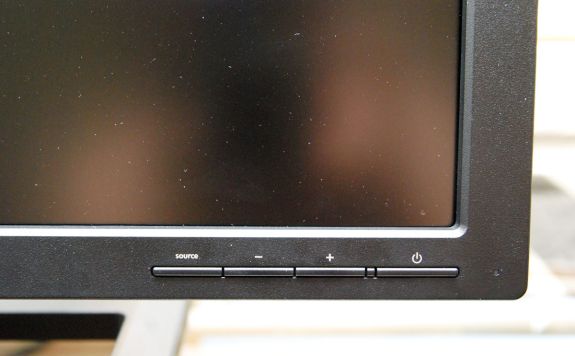A New 30" Contender: HP ZR30w Review
by Brian Klug on June 1, 2010 6:30 PM EST
Controls, but no On Screen Display
I’ve been putting off talking about those buttons at the bottom right of the display. Note that this far, I haven’t called them OSD buttons, because that’s just it - they’re not.
The ZR30w has no OSD. If you recall, neither did its predecessor, the HP LP3065. At that time, HP claimed there were no ICs that could drive an OSD at native 2560x1600 resolution. Apparently this is still the case.
I was a bit confused at first, so I checked the manual. It explicitly notes inside that the ZR30w has no OSD. This is still an interesting and radical choice. The four buttons allow you to change the source input from DVI-D to DisplayPort, control backlight brightness using + and -, and holding both + and - down simultaneously toggles dynamic contrast. Thankfully, HP ships with dynamic contrast turned off by default. Control feedback is communicated entirely through the blue LED at the right of the buttons. It’s intuitive and makes sense, but be aware that if you’re expecting RGB controls, color temperature, or other options you won’t find ‘em.
That brings me to the scaler IC, which I believe is related to the lack of traditional OSD. I noticed while looking through the manual that HP notes a “safe mode” resolution of 1280x800 next to the recommended native resolution of 2560x1600. Notice anything interesting about those numbers?
Sure enough, using 1280x800 results in a pixel-doubled but full screen image. Other resolutions are scaled as well, but I get the impression HP wants you to use the ZR30w at either native, or this "safe," aspect-ratio correct resolution exactly half of native. It’s an interesting and bold move to still not have an OSD, but in some ways it actually discourages the kind of wrong user control that can lead to insanity when trying to calibrate. But it’s still a bit of a surprise to see no OSD a generation later.
Viewing angles are superb as expected. HP advertises 178 degrees horizontal and vertical with a 10:1 contrast ratio. In practice, you shouldn’t ever really look at the monitor from those extreme angles, but there’s no reversal in contrast or vastly odd saturation at any extreme angle. In our subjective +/- 30 degree tests in vertical and horizontal directions, it looks equally good.

















95 Comments
View All Comments
MamiyaOtaru - Wednesday, June 2, 2010 - link
are they always s-ips? I love my lp2065, but I had to find one that was advertised specifically as s-ips since not all of them were D:Teemax - Wednesday, June 2, 2010 - link
Excellent review! I appreciate the efforts in measuring the input lag!Looks like my Dell 3007WFP finally has a worthy replacement.
Mr Perfect - Wednesday, June 2, 2010 - link
Yes, I'm glad to see it compared to a CRT rather then a "good enough" LCD with unknown input lag.Earballs - Wednesday, June 2, 2010 - link
I guess I have to assume it's 60Hz?Earballs - Wednesday, June 2, 2010 - link
redacted.melgross - Wednesday, June 2, 2010 - link
I've given up on the idea of moving to 30" from 24". I use my monitors mostly for Photoshop, video editing, publishing, etc. I've found that even IPS displays of various types show a change in brightness and contrast in the sides from sitting at the distance required for this work. Because of the large size, you're always looking at the edges at an angle that will make the difference noticeable.I've been looking at the new 27" displays for that reason. Apple's new 27" iMac doesn't have as much of a problem because of the slightly smaller size, but with the LED backlighting, they only claim an sRGB gamut. It's pretty good, but not for what I need.
Is the NEC on your to do list? I hope so. The Dell 2711 hasn't proven to be all that great.
omf - Wednesday, June 2, 2010 - link
Thanks for the detailed review! It seems rare to get good, technical data in reviews these days...I'm surprised you haven't included tests for the Dell 3008 display, though. I've heard mixed things about it and would love to see some test results.
Thanks again!
R4F43LZiN - Wednesday, June 2, 2010 - link
I would like to see a full "how to calibrate your display" one of those days here on AT. I mean, there are a few of those on the internet, but none with the kind of detail and technical aspects that we've come to expect from a AT article.MauveCloud - Wednesday, June 2, 2010 - link
"Considering other 30” displays include a plethora of input options"From my research of 2560x1600 monitors, only the Gateway XHD3000 (which I use now, though I had to get it repaired a couple of weeks ago - I did the research on possible replacements) and the Dell 3008WFP have component inputs, or are you referring to 30 inch televisions, with native resolution 1920x1080, rather than 2560x1600?.
"The ZR30w has no OSD. If you recall, neither did its predecessor, the HP LP3065. At that time, HP claimed there were no ICs that could drive an OSD at native 2560x1600 resolution. Apparently this is still the case."
My Gateway XHD3000 has an OSD at 2560x1600 (albeit not fullscreen), and so does the Dell UltraSharp 3008WFP.
phoible_123 - Wednesday, June 2, 2010 - link
I've used this cable to connect a macbook pro to my 23" NEC monitor with Displayport:http://www.buy.com/prod/mini-displayport-to-displa...
It actually transmits sound as well if the monitor has an integrated speaker.